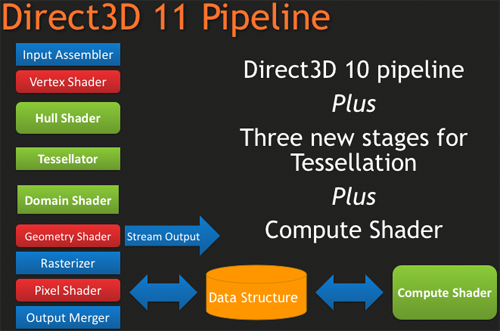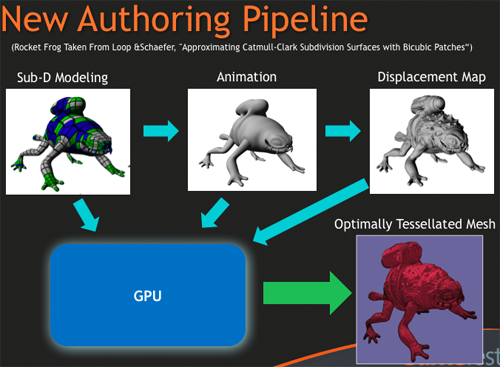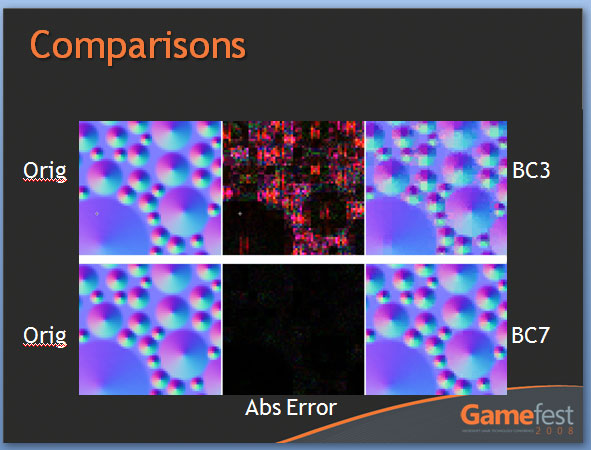AMD's Radeon HD 5870: Bringing About the Next Generation Of GPUs
by Ryan Smith on September 23, 2009 9:00 AM EST- Posted in
- GPUs
DirectX11 Redux
With the launch of the 5800 series, AMD is quite proud of the position they’re in. They have a DX11 card launching a month before DX11 is dropped on to consumers in the form of Win7, and the slower timing of NVIDIA means that AMD has had silicon ready far sooner. This puts AMD in the position of Cypress being the de facto hardware implementation of DX11, a situation that is helpful for the company in the long term as game development will need to begin on solely their hardware (and programmed against AMD’s advantages and quirks) until such a time that NVIDIA’s hardware is ready. This is not a position that AMD has enjoyed since 2002 with the Radeon 9700 and DirectX 9.0, as DirectX 10 was anchored by NVIDIA due in large part to AMD’s late hardware.
As we have already covered DirectX 11 in-depth with our first look at the standard nearly a year ago, this is going to be a recap of what DX11 is bringing to the table. If you’d like to get the entire inside story, please see our in-depth DirectX 11 article.
DirectX 11, as we have previously mentioned, is a pure superset of DirectX 10. Rather than being the massive overhaul of DirectX that DX10 was compared to DX9, DX11 builds off of DX10 without throwing away the old ways. The result of this is easy to see in the hardware of the 5870, where as features were added to the Direct3D pipeline, they were added to the RV770 pipeline in its transformation into Cypress.

New to the Direct3D pipeline for DirectX 11 is the tessellation system, which is divided up into 3 parts, and the Computer Shader. Starting at the very top of the tessellation stack, we have the Hull Shader. The Hull Shader is responsible for taking in patches and control points (tessellation directions), to prepare a piece of geometry to be tessellated.
Next up is the tesselator proper, which is a rather significant piece of fixed function hardware. The tesselator’s sole job is to take geometry and to break it up into more complex portions, in effect creating additional geometric detail from where there was none. As setting up geometry at the start of the graphics pipeline is comparatively expensive, this is a very cool hack to get more geometric detail out of an object without the need to fully deal with what amounts to “eye candy” polygons.
As the tesselator is not programmable, it simply tessellates whatever it is fed. This is what makes the Hull Shader so important, as it’s serves as the programmable input side of the tesselator.
Once the tesselator is done, it hands its work off to the Domain Shader, along with the Hull Shader handing off its original inputs to the Domain Shader too. The Domain Shader is responsible for any further manipulations of the tessellated data that need to be made such as applying displacement maps, before passing it along to other parts of the GPU.

The tesselator is very much AMD’s baby in DX11. They’ve been playing with tesselators as early as 2001, only for them to never gain traction on the PC. The tesselator has seen use in the Xbox 360 where the AMD-designed Xenos GPU has one (albeit much simpler than DX11’s), but when that same tesselator was brought over and put in the R600 and successive hardware, it was never used since it was not a part of the DirectX standard. Now that tessellation is finally part of that standard, we should expect to see it picked up and used by a large number of developers. For AMD, it’s vindication for all the work they’ve put into tessellation over the years.
The other big addition to the Direct3D pipeline is the Compute Shader, which allows for programs to access the hardware of a GPU and treat it like a regular data processor rather than a graphical rendering processor. The Compute Shader is open for use by games and non-games alike, although when it’s used outside of the Direct3D pipeline it’s usually referred to as DirectCompute rather than the Compute Shader.
For its use in games, the big thing AMD is pushing right now is Order Independent Transparency, which uses the Compute Shader to sort transparent textures in a single pass so that they are rendered in the correct order. This isn’t something that was previously impossible using other methods (e.g. pixel shaders), but using the Compute Shader is much faster.

Other features finding their way into Direct3D include some significant changes for textures, in the name of improving image quality. Texture sizes are being bumped up to 16K x 16K (that’s a 256MP texture) which for all practical purposes means that textures can be of an unlimited size given that you’ll run out of video memory before being able to utilize such a large texture.
The other change to textures is the addition of two new texture compression schemes, BC6H and BC7. These new texture compression schemes are another one of AMD’s pet projects, as they are the ones to develop them and push for their inclusion in DX11. BC6H is the first texture compression method dedicated for use in compressing HDR textures, which previously compressed very poorly using even less-lossy schemes like BC3/DXT5. It can compress textures at a lossy 6:1 ratio. Meanwhile BC7 is for use with regular textures, and is billed as a replacement for BC3/DXT5. It has the same 3:1 compression ratio for RGB textures.
We’re actually rather excited about these new texture compression schemes, as better ways to compress textures directly leads to better texture quality. Compressing HDR textures allows for larger/better textures due to the space saved, and using BC7 in place of BC3 is an outright quality improvement in the same amount of space, given an appropriate texture. Better compression and tessellation stand to be the biggest benefactors towards improving the base image quality of games by leading to better textures and better geometry.
We had been hoping to supply some examples of these new texture compression methods in action with real textures, but we have not been able to secure the necessary samples in time. In the meantime we have Microsoft’s examples from GameFest 2008, which drive the point home well enough in spite of being synthetic.

Moving beyond the Direct3D pipeline, the next big feature coming in DirectX 11 is better support for multithreading. By allowing multiple threads to simultaneously create resources, manage states, and issue draw commands, it will no longer be necessary to have a single thread do all of this heavy lifting. As this is an optimization focused on better utilizing the CPU, it stands that graphics performance in GPU-limited situations stands to gain little. Rather this is going to help the CPU in CPU-limited situations better utilize the graphics hardware. Technically this feature does not require DX11 hardware support (it’s a high-level construct available for use with DX10/10.1 cards too) but it’s still a significant technology being introduced with DX11.
Last but not least, DX11 is bringing with it High Level Shader Language 5.0, which in turn is bringing several new instructions that are primarily focused on speeding up common tasks, and some new features that make it more C-like. Classes and interfaces will make an appearance here, which will make shader code development easier by allowing for easier segmentation of code. This will go hand-in-hand with dynamic shader linkage, which helps to clean up code by only linking in shader code suitable for the target device, taking the management of that task out of the hands of the coder.










327 Comments
View All Comments
JonnyDough - Wednesday, September 23, 2009 - link
They could probably use a 1.5 GB card. :(yacoub - Wednesday, September 23, 2009 - link
why is the 5870 so freaking LONG??I'm pretty sure you could land aircraft on it.
http://images.anandtech.com/reviews/video/ATI/5870...">http://images.anandtech.com/reviews/video/ATI/5870...
Someone should photoshop a person into that image for scale. They'd be standing in the shadow underneath the PCIe connector, waving at you, and there would be an F-35 JSF circling like a fly trying to land on the deck.
Ryan Smith - Wednesday, September 23, 2009 - link
It's your standard, full-length 10.5" card. It's the same as the GTX cards and the 4870X2Here's a shot comparing it to a GTX 285 and a 4890 that I didn't get to use in the article.
http://images.anandtech.com/reviews/video/ATI/5870...">http://images.anandtech.com/reviews/video/ATI/5870...
SiliconDoc - Monday, September 28, 2009 - link
If you can't see the 5870 is the longest card in that pic, then you've got different problems than just lying issues.Another one, another big fat fib, with pic included, that proves the fib to be a fab fib.
It's amazing.
---
"No, everyone, do not believe your lying eyes, it's a standard 10.5" measured in the new red rooster barnyard stick."
Cripes call International Weights and Measures, we have warped space time around the new ati card it's so powerful.
LSnK - Wednesday, September 23, 2009 - link
Or plainly spoken, angle independent angle-dependent filtering. How confusing.frozentundra123456 - Wednesday, September 23, 2009 - link
Mildly disappointed in the initial results for this card. It is powerful,admittedly, but it has less than twice the performance of the 4870. Also does not use less power. Maybe I was expecting too much. It surely is not a giant step up like the introduction of the 4xxx series cards. I was hoping for another big leap in performance per watt.I have a feeling that nVidia's 300 series will beat it when it finally comes out, although hopefully ATI will still be ahead in performance per watt and performance per dollar.
I hope they make a good low/midrange card like the 4670 that does not require external power but has increased performance.
Spoelie - Wednesday, September 23, 2009 - link
I reckon you'll see performance improve the coming months, as ATi's compiler improves to use the new instructions more efficiently. The card you see here today will not be the one fighting GT300.Granted, it won't make huge strides, but I guesstimate it to be 5-10% better, depending on circumstance/game, by the november-january timeframe (when GT300 hopefully lands).
Nvidia's baby will probably still be faster, but if the margin turns out to be slim, we'll have another rv770 vs GT200 situation playing out. And when the first wave of DX11 games have hit, somewhere next year, it'll be time to reevaluate again ;).
JonnyDough - Wednesday, September 23, 2009 - link
and I stopped. I had to post this:"Sometimes a surprise is nice. Other times it’s nice for things to go as planned for once.
Compared to the HD 4800 series launch, AMD’s launch of the HD 5800 series today is going to fall in to the latter category. There are no last-minute announcements or pricing games, or NDAs that get rolled back unexpectedly. Today’s launch is about as normal as a new GPU launch can get."
If it's normal for all that crap to happen, wouldn't it be ABNORMAL for AMD to have a great launch? :)
SiliconDoc - Wednesday, September 23, 2009 - link
LOL" . Today’s launch is about as normal as a new GPU launch can get."
I guess he meant "for reviewers" - since the "normal launch" today is "listed on the websites for sale, but greyed out, not available, or pre-order" - meaning NO STOCK.
---
Yehah buddy, that is a "as normal as any launch" so long as it's the immensely favored ATI launching, and not that hated greedy Nvidia...
A normal launch and you can't buy the card...rofl.
JonnyDough - Thursday, September 24, 2009 - link
I wasn't being a fanboi, merely mocking normal launches from several companies. Seems like paper launches almost became the norm for awhile. :P